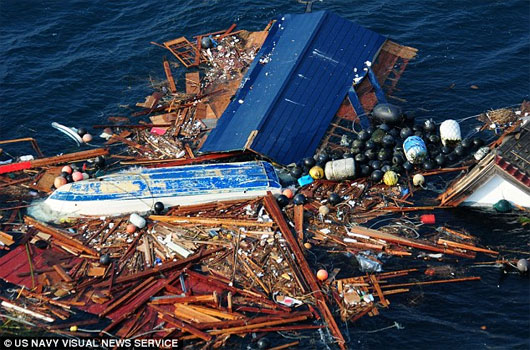Garbage island is twice as large as Vietnam's land area about to dock
The huge waste-sized island of Texas is on its way to land in the US, threatening to cause catastrophe for human and marine life.
US authorities warn, one million tons of garbage is floating in the waters between the Hawaiian Islands and the state of California. This is one of the horrifying consequences of the earthquake accompanied by tsunami hit Japan in 2011.
The 'toxic monster' occupies the US equivalent of the Texas state (678,907km 2 ), twice the size of Vietnam's land (331,698km 2 according to wikipedia data).

Junk Japanese tsunami on the way to America.(Photo: Daily Mail)
The focal point of the trash island is 2,700km from the US coast. If the garbage continues to merge, it will form a floating island larger than the size of America. Theoretically, the garbage island into North America could reach 5 million tons.
The trash island component includes boats, houses, electronic devices to home appliances. They were pulled away from Japanese territory by the tsunami after the double disaster in March 2011. Although closely monitoring the path of the garbage island, the US still could not predict exactly where it landed, although they were located very close to the US coast.
In fact, light garbage such as buoy and gallon began to arrive in North America at the end of last year. Previously, a ball was found, a Harley in a box or even a rusted ship . drifted to the North American coast.
Scientists warn, tsunami garbage will destroy the marine environment, harming wild animals and plants in the areas they sweep. Corals are covered with plastic, dead fish are caught by drift nets following garbage islands, birds die from eating plastic . are the harms that these huge garbage islands are causing.
The Japanese Ministry of Environment estimates that about 5 million tons of garbage are swept away by the tsunami into the ocean in a double disaster. However, only 30% of them are capable of floating in the vast Pacific Ocean. The rest had sunk to the bottom of the sea shortly after being pulled from the mainland.
- The giant Pacific Island trash island will be cleared with this wonderful system
- The Earth is about to lose 1/3 of its food land
- The real penguin lives on the trash island
- Discover new islands in the Arctic
- Garbage in the Pacific increased 100 times
- Tighten your heart in front of a dead bird on a remote island
- Sony Built-in Speaker Dock
- The most isolated land
- Plastic landfill on the sea is as large as 3 European countries
- Island on land
- Unbelievably shocking images of garbage in Ly Son
- China built the world's largest garbage power plant
 Is the magnetic North Pole shift dangerous to humanity?
Is the magnetic North Pole shift dangerous to humanity? Washington legalizes the recycling of human bodies into fertilizer
Washington legalizes the recycling of human bodies into fertilizer Lightning stone - the mysterious guest
Lightning stone - the mysterious guest Stunned by the mysterious sunset, strange appearance
Stunned by the mysterious sunset, strange appearance